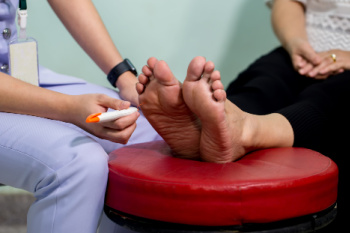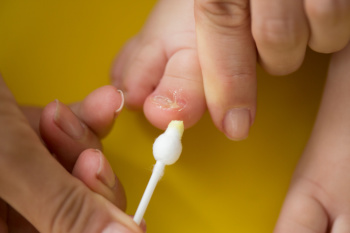Connect With Us
Blog
Items filtered by date: April 2024
What Is Diabetic Neuropathy?
 Diabetic neuropathy is a complication of diabetes that occurs when high blood sugar levels cause damage to nerve fibers. The nerves in the legs and feet are primarily affected. This can lead to symptoms such as numbness, tingling, pain, and weakness in the affected areas. Patients typically have a difficult time feeling heat, cold, or pain. This reduced sensation increases the risk of injuries going unnoticed and becoming infected, potentially leading to severe complications. A podiatrist, or foot doctor, plays an important role in managing diabetic neuropathy by conducting regular foot examinations to monitor for potential injuries that patients may not detect themselves. They can also provide guidance on proper foot care practices, recommend suitable footwear to protect the feet, and promptly treat any foot problems, such as ulcers or infections. If you have neuropathy, it is suggested that you regularly consult a podiatrist to monitor any foot concerns.
Diabetic neuropathy is a complication of diabetes that occurs when high blood sugar levels cause damage to nerve fibers. The nerves in the legs and feet are primarily affected. This can lead to symptoms such as numbness, tingling, pain, and weakness in the affected areas. Patients typically have a difficult time feeling heat, cold, or pain. This reduced sensation increases the risk of injuries going unnoticed and becoming infected, potentially leading to severe complications. A podiatrist, or foot doctor, plays an important role in managing diabetic neuropathy by conducting regular foot examinations to monitor for potential injuries that patients may not detect themselves. They can also provide guidance on proper foot care practices, recommend suitable footwear to protect the feet, and promptly treat any foot problems, such as ulcers or infections. If you have neuropathy, it is suggested that you regularly consult a podiatrist to monitor any foot concerns.
Neuropathy
Neuropathy can be a potentially serious condition, especially if it is left undiagnosed. If you have any concerns that you may be experiencing nerve loss in your feet, consult with Gerald Erskine, DPM from Seneca Family Footcare. Our doctor will assess your condition and provide you with quality foot and ankle treatment for neuropathy.
What Is Neuropathy?
Neuropathy is a condition that leads to damage to the nerves in the body. Peripheral neuropathy, or neuropathy that affects your peripheral nervous system, usually occurs in the feet. Neuropathy can be triggered by a number of different causes. Such causes include diabetes, infections, cancers, disorders, and toxic substances.
Symptoms of Neuropathy Include:
- Numbness
- Sensation loss
- Prickling and tingling sensations
- Throbbing, freezing, burning pains
- Muscle weakness
Those with diabetes are at serious risk due to being unable to feel an ulcer on their feet. Diabetics usually also suffer from poor blood circulation. This can lead to the wound not healing, infections occurring, and the limb may have to be amputated.
Treatment
To treat neuropathy in the foot, podiatrists will first diagnose the cause of the neuropathy. Figuring out the underlying cause of the neuropathy will allow the podiatrist to prescribe the best treatment, whether it be caused by diabetes, toxic substance exposure, infection, etc. If the nerve has not died, then it’s possible that sensation may be able to return to the foot.
Pain medication may be issued for pain. Electrical nerve stimulation can be used to stimulate nerves. If the neuropathy is caused from pressure on the nerves, then surgery may be necessary.
If you have any questions, please feel free to contact our office located in Ronceverte, WV . We offer the newest diagnostic and treatment technologies for all your foot care needs.
Hammertoe Surgery Risk Factors

Hammertoe is a deformity of the second, third, or fourth toe that causes a bend at the middle joint so that it resembles a hammer. A hammertoe can significantly affect mobility and cause discomfort, especially while wearing shoes. Conservative treatment measures include wearing proper footwear and orthotics, but more severe cases may necessitate surgical intervention which carries certain risks. Post-operative complications may include pain, swelling, and difficulty in weight bearing. Nerve damage leading to sensations of numbness or tingling, reduced range of motion in the toe, and the risk of infection at the surgical site are further risk factors. Additionally, there is a possibility of the toe not sitting completely flat on the ground after surgery, which can affect balance and mobility. To determine the best course in managing a hammertoe, it is suggested that you schedule an appointment with a podiatrist to find out if surgery is right for you.
Foot surgery is sometimes necessary to treat a foot ailment. To learn more, contact Gerald Erskine, DPM of Seneca Family Footcare. Our doctor will assist you with all of your foot and ankle needs.
When Is Surgery Necessary?
Foot and ankle surgery is generally reserved for cases in which less invasive, conservative procedures have failed to alleviate the problem. Some of the cases in which surgery may be necessary include:
- Removing foot deformities like bunions and bone spurs
- Severe arthritis that has caused bone issues
- Cosmetic reconstruction
What Types of Surgery Are There?
The type of surgery you receive will depend on the nature of the problem you have. Some of the possible surgeries include:
- Bunionectomy for painful bunions
- Surgical fusion for realignment of bones
- Neuropathy decompression surgery to treat nerve damage
Benefits of Surgery
Although surgery is usually a last resort, it can provide more complete pain relief compared to non-surgical methods and may allow you to finally resume full activity.
Surgical techniques have also become increasingly sophisticated. Techniques like endoscopic surgery allow for smaller incisions and faster recovery times.
If you have any questions please feel free to contact our office located in Ronceverte, WV . We offer the newest diagnostic and treatment technologies for all your foot and ankle needs.
Common Symptoms and Causes of Gout

Gout, an inflammatory ailment caused by excess uric acid, often triggers sudden and severe joint pain. Commonly affecting the big toe, gout attacks are often described as feeling like a fracture or a severe burn. Along with the intense pain, symptoms include visible swelling, redness, and inflammation in the affected joint, making movement difficult and leading to stiffness. These symptoms tend to worsen over time if left untreated, potentially causing joint deformity and long-term complications. Recurrent gout attacks can occur in clusters, affecting both mobility and overall quality of life. Seeking professional help from a podiatrist is essential for comprehensive care, including diagnosis, treatment, and long-term management. Podiatrists can offer a combination of medication, lifestyle adjustments, and preventive strategies to alleviate gout symptoms and reduce the risk of future attacks. If you experience such painful symptoms, particularly in your big toe, it is suggested that you are under the care of a podiatrist for treatment.
Gout is a foot condition that requires certain treatment and care. If you are seeking treatment, contact Gerald Erskine, DPM from Seneca Family Footcare. Our doctor will treat your foot and ankle needs.
What Is Gout?
Gout is a type of arthritis caused by a buildup of uric acid in the bloodstream. It often develops in the foot, especially the big toe area, although it can manifest in other parts of the body as well. Gout can make walking and standing very painful and is especially common in diabetics and the obese.
People typically get gout because of a poor diet. Genetic predisposition is also a factor. The children of parents who have had gout frequently have a chance of developing it themselves.
Gout can easily be identified by redness and inflammation of the big toe and the surrounding areas of the foot. Other symptoms include extreme fatigue, joint pain, and running high fevers. Sometimes corticosteroid drugs can be prescribed to treat gout, but the best way to combat this disease is to get more exercise and eat a better diet.
If you have any questions please feel free to contact our office located in Ronceverte, WV . We offer the newest diagnostic and treatment technologies for all your foot and ankle needs.
Podiatrists Effectively Treat Ingrown Toenails
 Podiatrists specialize in treating foot conditions, including the common yet painful issue of ingrown toenails. These occur when the edge of a toenail grows into the surrounding skin, causing discomfort, redness, and even infection. When treating an ingrown toenail, a podiatrist may start with conservative treatments, such as properly trimming the nail, lifting it from the skin, and recommending appropriate footwear to alleviate pressure. In cases where the ingrown toenail is recurrent or severe, a podiatrist may perform a minor surgical procedure under local anesthesia to remove part of the nail. This professional intervention not only addresses the immediate pain and infection but can also prevent recurrence of ingrown nails in that area. Patients can usually return to their daily activities quickly and comfortably, with minimal risk of complications. If you are suffering from an ingrown toenail, it is suggested that you consult a podiatrist for treatment.
Podiatrists specialize in treating foot conditions, including the common yet painful issue of ingrown toenails. These occur when the edge of a toenail grows into the surrounding skin, causing discomfort, redness, and even infection. When treating an ingrown toenail, a podiatrist may start with conservative treatments, such as properly trimming the nail, lifting it from the skin, and recommending appropriate footwear to alleviate pressure. In cases where the ingrown toenail is recurrent or severe, a podiatrist may perform a minor surgical procedure under local anesthesia to remove part of the nail. This professional intervention not only addresses the immediate pain and infection but can also prevent recurrence of ingrown nails in that area. Patients can usually return to their daily activities quickly and comfortably, with minimal risk of complications. If you are suffering from an ingrown toenail, it is suggested that you consult a podiatrist for treatment.
Ingrown toenails may initially present themselves as a minor discomfort, but they may progress into an infection in the skin without proper treatment. For more information about ingrown toenails, contact Gerald Erskine, DPM of Seneca Family Footcare. Our doctor can provide the care you need to keep you pain-free and on your feet.
Ingrown Toenails
Ingrown toenails are caused when the corner or side of a toenail grows into the soft flesh surrounding it. They often result in redness, swelling, pain, and in some cases, infection. This condition typically affects the big toe and may recur if it is not treated properly.
Causes
- Improper toenail trimming
- Genetics
- Improper shoe fitting
- Injury from pedicures or nail picking
- Abnormal gait
- Poor hygiene
You are more likely to develop an ingrown toenail if you are obese, have diabetes, arthritis, or have any fungal infection in your nails. Additionally, people who have foot or toe deformities are at a higher risk of developing an ingrown toenail.
Symptoms
Some symptoms of ingrown toenails are redness, swelling, and pain. In rare cases, there may be a yellowish drainage coming from the nail.
Treatment
Ignoring an ingrown toenail can have serious complications. Infections of the nail border can progress to a deeper soft-tissue infection, which can then turn into a bone infection. You should always speak with your podiatrist if you suspect you have an ingrown toenail, especially if you have diabetes or poor circulation.
If you have any questions, please feel free to contact our office located in Ronceverte, WV . We offer the newest diagnostic and treatment technologies for all your foot care needs.
Are You Suffering From Ingrown Toenails?
Complications From Blisters on the Feet
 Blisters on the feet, though seemingly minor, can lead to more serious complications if not treated properly. These small pockets of fluid form as a result of friction or pressure, commonly from wearing ill-fitting shoes or increased physical activity. While they often heal on their own, blisters can become infected. Infections are indicated by increased pain, redness, swelling, or the presence of pus. It is important to seek medical attention if there are signs of infection, which can escalate into cellulitis, a deeper, more serious skin infection that can spread quickly. For individuals with diabetes or compromised immune systems, the risk of complications from foot blisters is significantly higher. These conditions can impair blood circulation and wound healing, making even small blisters potential gateways to severe infections. If you have a blister that is showing signs of infection, especially if a blister is not healing as expected, it is suggested that you schedule an appointment with a podiatrist as quickly as possible.
Blisters on the feet, though seemingly minor, can lead to more serious complications if not treated properly. These small pockets of fluid form as a result of friction or pressure, commonly from wearing ill-fitting shoes or increased physical activity. While they often heal on their own, blisters can become infected. Infections are indicated by increased pain, redness, swelling, or the presence of pus. It is important to seek medical attention if there are signs of infection, which can escalate into cellulitis, a deeper, more serious skin infection that can spread quickly. For individuals with diabetes or compromised immune systems, the risk of complications from foot blisters is significantly higher. These conditions can impair blood circulation and wound healing, making even small blisters potential gateways to severe infections. If you have a blister that is showing signs of infection, especially if a blister is not healing as expected, it is suggested that you schedule an appointment with a podiatrist as quickly as possible.
Blisters may appear as a single bubble or in a cluster. They can cause a lot of pain and may be filled with pus, blood, or watery serum. If your feet are hurting, contact Gerald Erskine, DPM of Seneca Family Footcare. Our doctor can provide the care you need to keep you pain-free and on your feet.
Foot Blisters
Foot blisters are often the result of friction. This happens due to the constant rubbing from shoes, which can lead to pain.
What Are Foot Blisters?
A foot blister is a small fluid-filled pocket that forms on the upper-most layer of the skin. Blisters are filled with clear fluid and can lead to blood drainage or pus if the area becomes infected.
Symptoms
(Blister symptoms may vary depending on what is causing them)
- Bubble of skin filled with fluid
- Redness
- Moderate to severe pain
- Itching
Prevention & Treatment
In order to prevent blisters, you should be sure to wear comfortable shoes with socks that cushion your feet and absorb sweat. Breaking a blister open may increase your chances of developing an infection. However, if your blister breaks, you should wash the area with soap and water immediately and then apply a bandage to the affected area. If your blisters cause severe pain it is important that you call your podiatrist right away.
If you have any questions, please feel free to contact our office located in Ronceverte, WV . We offer the newest diagnostic and treatment technologies for all your foot care needs.

